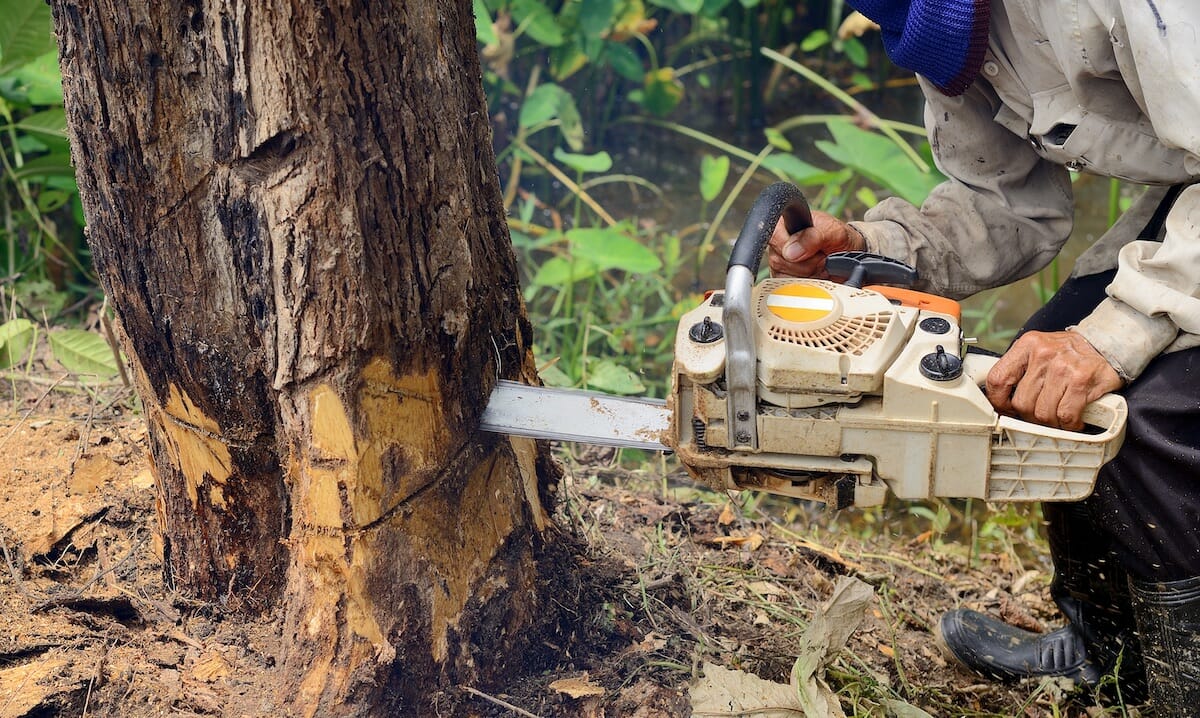How much does tree removal cost?

First things first, you should know that there is no clear cut process to ascertain the costs involved in getting a tree removed. The complexity of the job, the height and type of tree all play a role in how expensive it will all be. This is just a rough guide based on generally acceptable parameters. With that said, let’s discuss further.
Is Tree removal expensive?
Well, it depends. Tree removal can cost anywhere in the range of $150 and $2,000 which sounds like a pretty wide range but there’s a reason. There are multiple factors like height, location, complexity of the job that affect tree removal and in most cases, it is in fact quite expensive and requires specialized assistance. While $150 is a pretty small sum, it is the lower end of the scale and an exception. Tack on extras like limb removal, trunk removal stump removal and you are easily looking at adding a couple of hundred dollars to the cost. Let’s break it down further.
Height
Height is the single most important cost determinant for tree removal. Even more than the particular species, it’s the size that play a role in bringing up the cost. Large trees like a mature oak can easily cost up to an average of $1300 dollars to remove. However, if you are looking to remove small fruit trees under 30 feet in height, you will only be paying somewhere between $150 and $500. For extra tall trees over 80 feet, $1000-$2000 is the average cost range.
An important note to make here-height isn’t the only component of size. Tall trees with narrower trunks might cost a little less to remove compared to a tree with a thick trunk. Basically, the more labor intensive the process, the higher the cost. Say you have a relatively short tree but with more than one trunk that are also thick, you’ll automatically end up paying more.
If you want an average estimate, keep a budget of $700-750 dollars minimum for a tree removal job. And make sure whatever you do, don’t scrimp on cost by attempting to do the job yourself. A professional and licensed arborist comes with years of training and experience handling the most precarious of jobs which cannot be substituted by a novice attempt.
Type of Tree
The cost of a tree also varies based on the particular species. Let’s clarify more. Cedar trees range vastly in size. Some cedars grow up to 160 while others around 230 feet. The average cost for removing a cedar tree will be in the general range of $250 to $1,500. Pine Trees have thick trunks and grow up to a whopping 100 feet which means tree removal will also range widely from $250 to $1,500. Oak Trees can also cost a lot to remove based on their average height. Again, the cost ranges from $200 to $2,000. A fully grown ash tree has an average height in the range of 40–80 feet with an average cost between $500 and $1,000 for removal.
Location & Position of Tree
The location and position of a tree is an additional factor in ascertaining tree removal costs. Some trees fall in the protected category and will require special permission to get removed adding to the cost. The area where you live-expensive, luxury area with a high cost of living or rural, out of city limits spot will also factor in the price. Generally, tree removal will cost more for desirable areas in the middle of the city. Getting a tree removed from an especially remote location will also cost you because of the travel costs involved in getting there.
The location and accessibility can in fact affect tree removal cost by 25-50 percent. By accessibility, we mean the positioning of a tree. If your tree is positioned in a hard to reach area such as in a narrow space between two large structures or close built houses, you will end up paying more. A tree located precariously close a to a power line will also cost more to remove. In short, the risk involved and difficulty of the job plays a role determining the cost.
Emergency Removal
Got a damaged, decayed, unstable tree on the verge of falling? Chance are you’ll need to schedule an urgent tree removal which could substantially add to the price. When you hire somebody for an urgent job, you are likely taking them away from other pre-scheduled work which means you’ll end up paying the difference. While a tree that is on the verge of falling may be theoretically easier to fell down and remove, the urgency of the matter is what really matters. However, keep in mind, if the tree has already fallen, it will require less time to remove and as a result be cheaper. Even for rush jobs if all that’s needed is to chop up and remove the tree from the premises, you’ll end up paying just $100 – $300.
Post-Natural Disaster Removal & Risk Involved
Chances are you’ll have to pay extra for scheduling an urgent tree removal after a city wide storm, cyclone or other natural disaster. As the demand for tree removal service will be high, you might have to pay for getting the job done. A tree that’s on the verge of falling after a storm or other disaster will also be a riskier operation for professionals. They will need to take extra time and precautions which will amp up the price too. While the price varies, unforeseen situations like these could end up costing you up to $5000.
Final Checklist
If you read all this way through, you’ll have figured Tree removal is expensive. However, there are ways you can save a few bucks here and there. In addition, there are certain tips you must be aware of before scheduling a job. Read on.
· To avoid unforeseen costs down the road, schedule an annual inspection by a licensed arborist. This is especially important if your property has many large trees that could be significantly expensive to remove in case of an emergency. An arborist can better guide you on tree maintenance so you can extend your tree lifespan.,
· Before scheduling a tree removal, check to make sure if tree removal isn’t already covered by homeowners insurance. In cases of tree removal promoted by storms or natural disaster, your insurance would cover the costs fully.
· Consult with at least three top tree removal companies and thoroughly compare quotes before scheduling a job. In addition, make sure to ask if bulk jobs with multiple tree needing removal would qualify for a discount. Also make sure they have business insurance for their tree removal services.
· While a professional is the best and safest option in most cases, you can save some money by cutting down small trees on your own. Trees under 15 feet are your best bet for tackling yourself.
· How to remove a tree for free is a common question. And the answer is you can in fact get lucky. If the trees in your property are part of a city, state of federal program, you might qualify for free removal. If your tree is located close to a power line and are a safety hazard, power companies could offer to remove a tree for free. Check in with your local power company for emergency tree removal help. Lumber companies might also be wiling to remove a tree for free if they can take the wood and its in good condition.
Make sure you have all your bases covered and have done your due diligence before scheduling a tree removal. Our suggestions will give you a framework for things to keep in mind pre scheduling. Ultimately, remember safety should be a homeowner’s primary concern and it is better to pay a large amount upfront than risk destroying your house or neighbors down the road.

